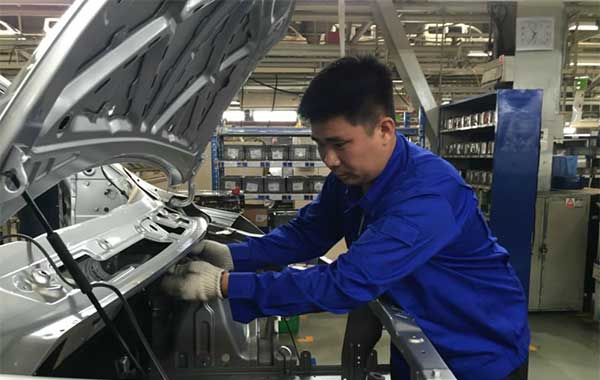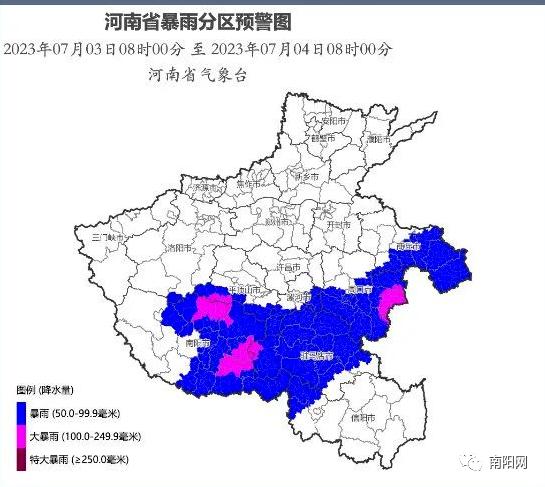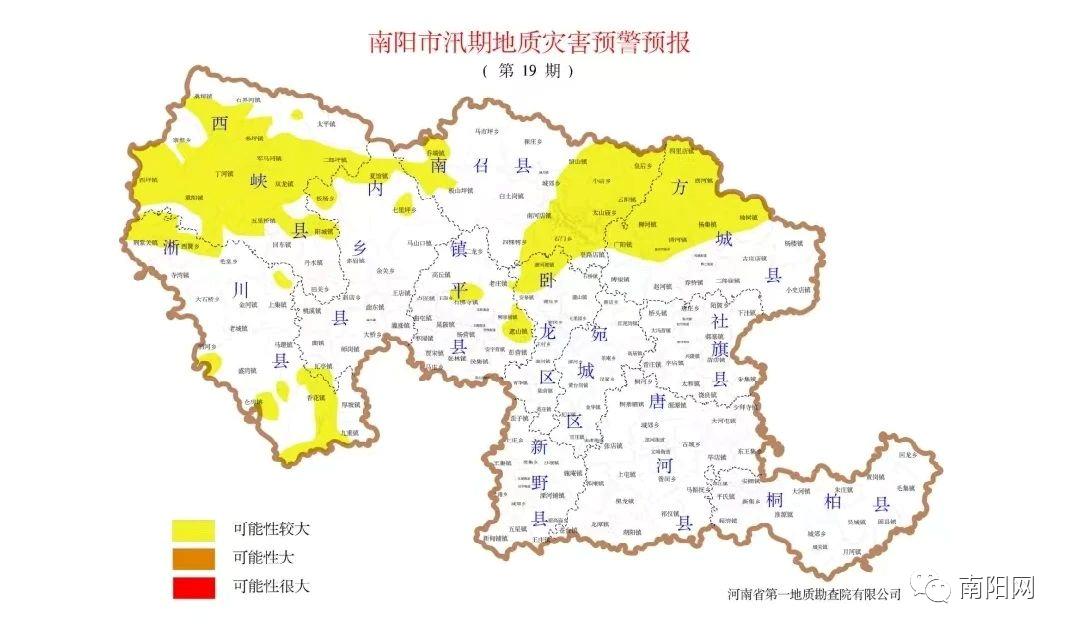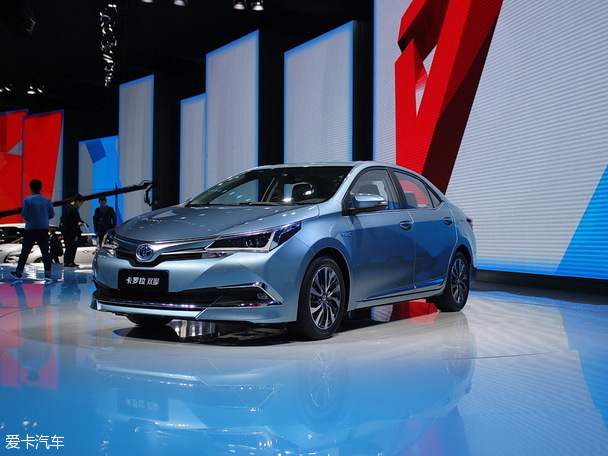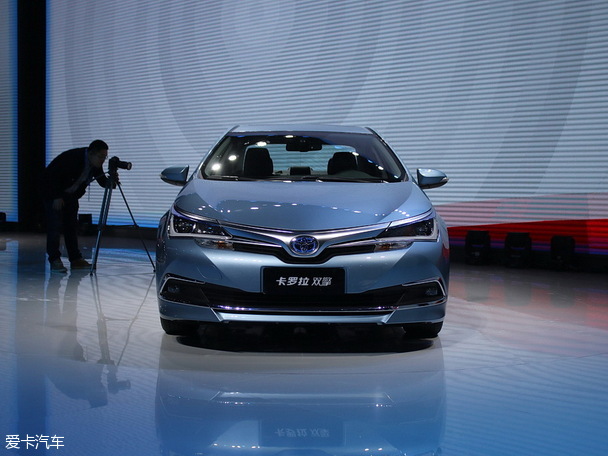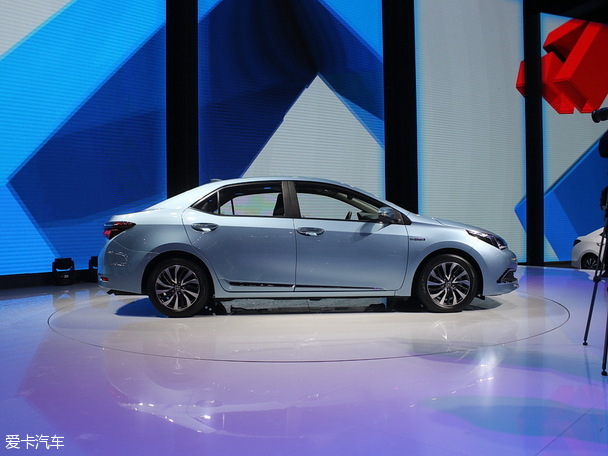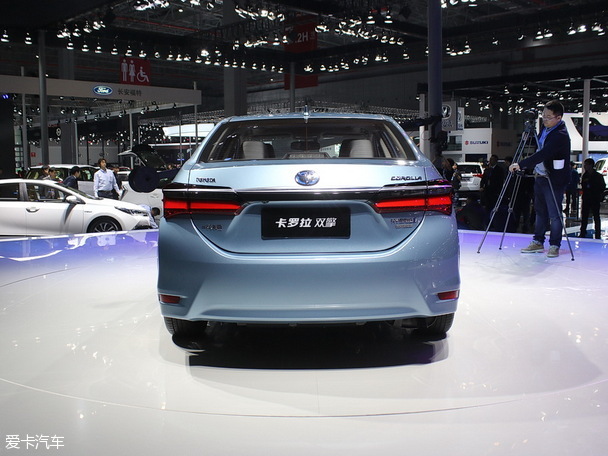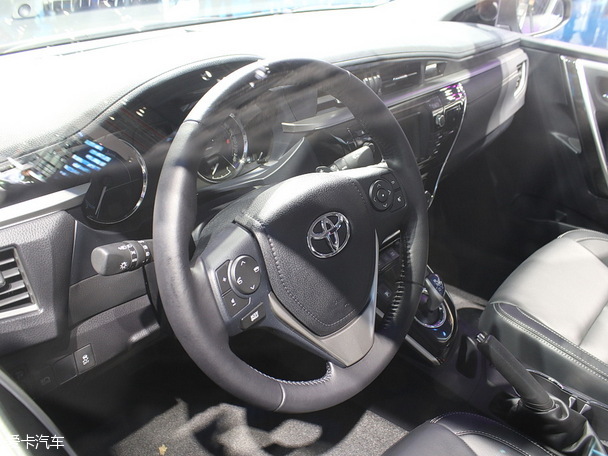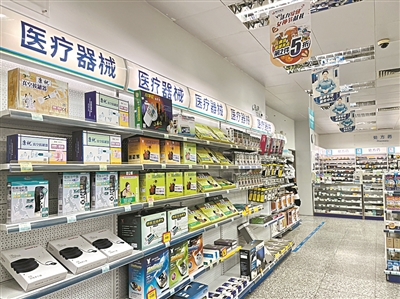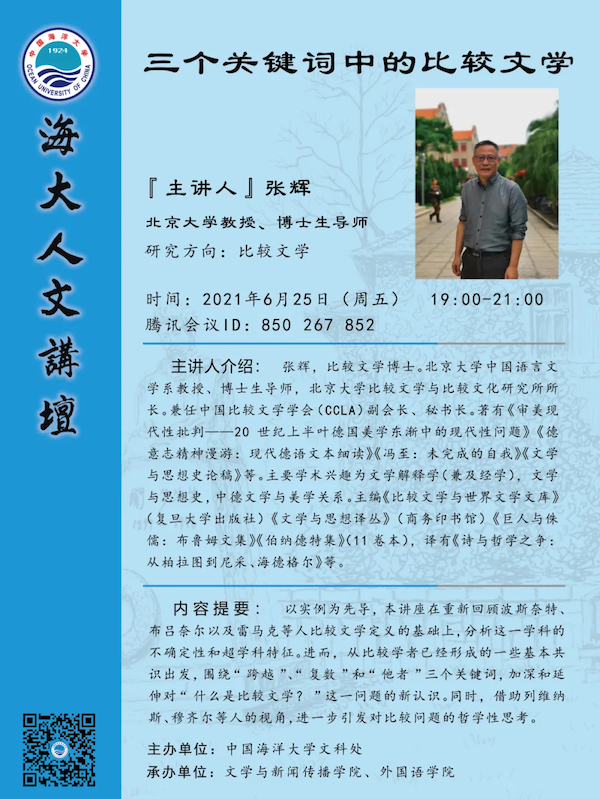
Comparative literature in three key words
Time:June 25th (Friday) 19:00-21:00.
Location:Tencent conference (ID: 850267852)
Speaker:Zhang Hui (Professor and Doctoral Supervisor, Chinese Department, Peking University)
Taking examples as the guide, this lecture reviews the definitions of comparative literature by Bosnett, Brunel and remarque, and analyzes the uncertainty and interdisciplinary characteristics of this subject. Furthermore, starting from some basic consensus that comparative scholars have formed, this paper deepens and extends the new understanding of "what is comparative literature" around three key words: "leap", "plural" and "the other". At the same time, with the help of the perspectives of Levinas, Muzil and others, the philosophical thinking on comparative problems is further triggered.

The story of a blind girl and a small town in Malay —— A new book sharing meeting of Li Zishu’s Land of Vulgarity
Time:19:00 on June 26th (Saturday)
Location:Hey, Beijing News APP, Weibo, Aauto Quicker, Tik Tok, etc.
Guest:Wang Anyi (writer), Chen Sihe (senior professor of liberal arts and doctoral supervisor of Fudan University), Zhai Yejun (professor of Chinese Department of Zhejiang University) and Li Zishu (writer).
In recent years, Malaysian Chinese literature (referred to as "Malaysian Chinese literature") has gradually entered our field of vision. Li Zishu, the protagonist of this activity and the author of "Vulgar Land", turned the big problem into an obscure obsession from the trivial daily life of dressing and eating through grotesque, delicate and realistic stories from her female perspective. On June 26th, Chen Sihe, a professor at Fudan University, Zhai Yejun, a professor at Zhejiang University, and Li Zishu, a Malaysian writer and author of "Land of Vulgarity", were invited by the Beijing News Book Review Weekly and Cultural Living Room in conjunction with Beijing October Literature and Art Publishing House to talk about Malaysian literature and a story about a blind girl and a small Malay town …
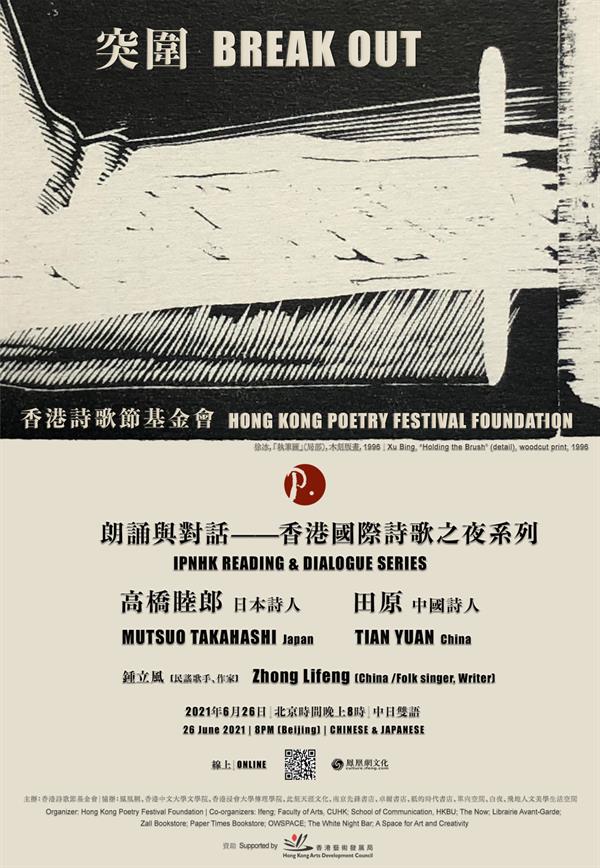
Breakthrough: Recitation and Dialogue Scene 4-International Poetry Nights in Hong Kong Series
Time:20:00 on June 26th (Saturday)
Location:Phoenix net
Guest:Gao Qiao Mu Lang (poet) and Tian Yuan (poet)
Gao Qiao Mulang, born on December 15th, 1937, is one of the most outstanding and prolific male poets, essayists and writers in contemporary Japan. He has more than 30 books of poetry, several prose works, dozens of prose monographs and several important literary awards. In the fourth scene of International Poetry Nights in Hong Kong series, we invited Gao Qiao Mulang to talk with China poet Tian Yuan, and invited musician Zhong Lifeng as the guest performer.
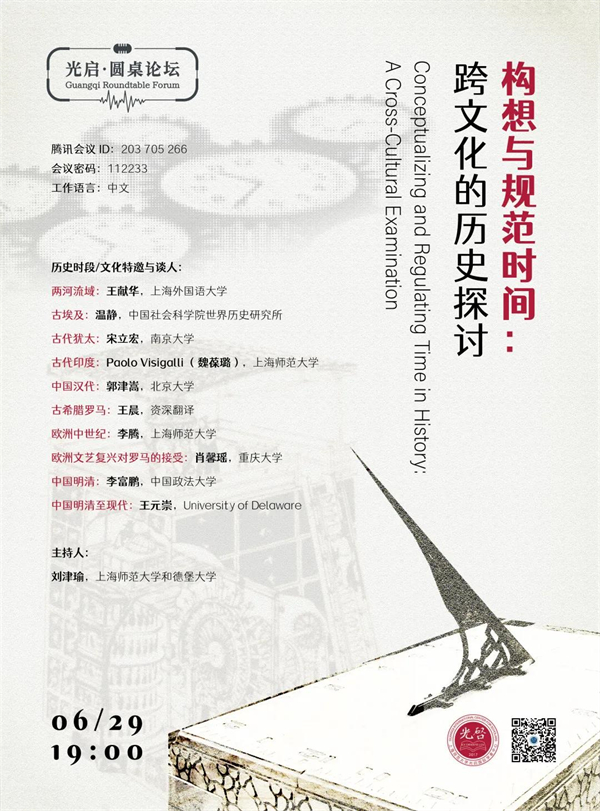
Conceiving and standardizing time: a cross-cultural historical discussion
Time:19:00 on Tuesday, June 29th.
Location:Tencent conference (ID: 203705266, password: 112233)
Guest:Guo Jinsong (postdoctoral fellow, Department of History, Peking University), Li Fupeng (Associate Professor, School of Law, China University of Political Science and Law), Liu Jinyu (Professor, Department of World History, Shanghai Normal University, Professor, Department of Classics, Depot University, USA), Wang Xianhua (Professor, Doctoral Supervisor, Shanghai International Studies University), Wang Yuanchong (Associate Professor, Department of History, University of Delaware, USA), etc.
What are the ways and paths to regulate time in history? Is there any essential difference between the time under the framework of empire and the time of polis? What historical enlightenment can we get from comparing the societies in different time frames? How do the ways of constructing and regulating time between different cultures influence each other? Is there any difference or change in individual’s cognition of time due to different social, economic and political status? This round-table forum adopts the perspective of seeing the big from the small, and takes dialogue as the main form, expecting the knowledge collision between researchers from two river basins, ancient Egypt, ancient India, Judaism, ancient Greece and Rome, the Middle Ages, China and other different cultures or different historical periods.
Attachment: Preview of offline activities
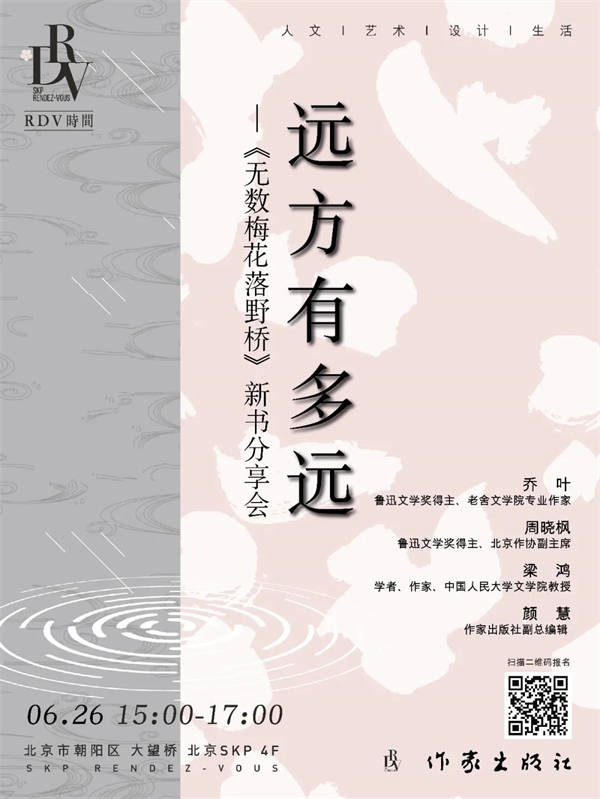
Beijing | How Far Is It? —— A New Book Sharing Meeting of Countless Plum Blossoms Falling on the Wild Bridge
Time:June 26th (Saturday) 15:00-17:00.
Location:SKP RENDEZ-VOUS, 4th floor, Beijing SKP Shopping Center, No.87 Jianguo Road, Chaoyang District
Guest:Qiao Ye (writer), Zhou Xiaofeng (writer), Liang Hong (scholar, writer, professor of China Renmin University) and Yan Hui (deputy editor-in-chief of Writers Publishing House).
Countless Plum Blossoms Falling on the Wild Bridge is the first collection of beautiful travel essays by Qiao Ye, a famous writer, and many of them have been selected for senior high school Chinese reading analysis and senior high school Chinese examination papers. How far is it? It can be in the sky or in front of you. Fortunately, in the days when the mind can’t soar, there are still good books that can put wings on us. Let travel become a habit, and let all journeys be accompanied by beautiful scenery. On June 26th, we invited writer Zhou Xiaofeng, scholar and writer Liang Hong, Yan Hui, deputy editor-in-chief of Writers Publishing House, and Qiao Ye, the author of "Numerous Plum Blossoms Fall on the Wild Bridge", to visit SKP in Beijing to talk about the distant and immediate scenery.
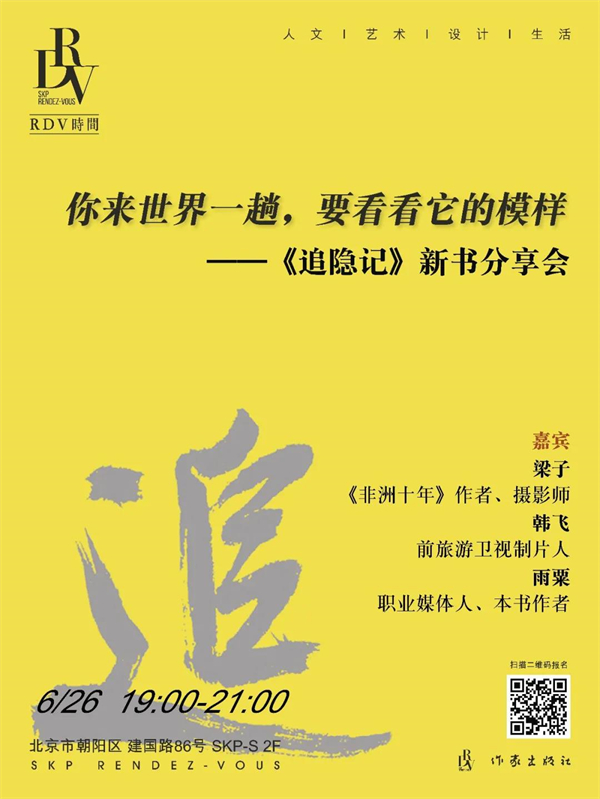
Beijing | When you come to the world, you should see what it looks like —— A new book sharing session of "Chasing the Hidden"
Time:June 26th (Saturday) 19:00-21:00
Location:SKP RENDEZ-VOUS, Floor 2, Beijing SKP-S Shopping Center, No.86 Jianguo Road, Chaoyang District
Guest:Liang Zi (photographer), Han Fei (former travel channel producer), Yu Su (media person)
In 2021, when the epidemic is still raging, have you been away for a long time to see what the world looks like? On June 26th, we invited Liang Zi, the author of Africa Decade, a photographer, Han Fei, a former travel channel producer, and Yu Su, a professional media person and the author of Chasing the Hidden Story, to visit SKP-S and talk about the distant place where our hearts are.
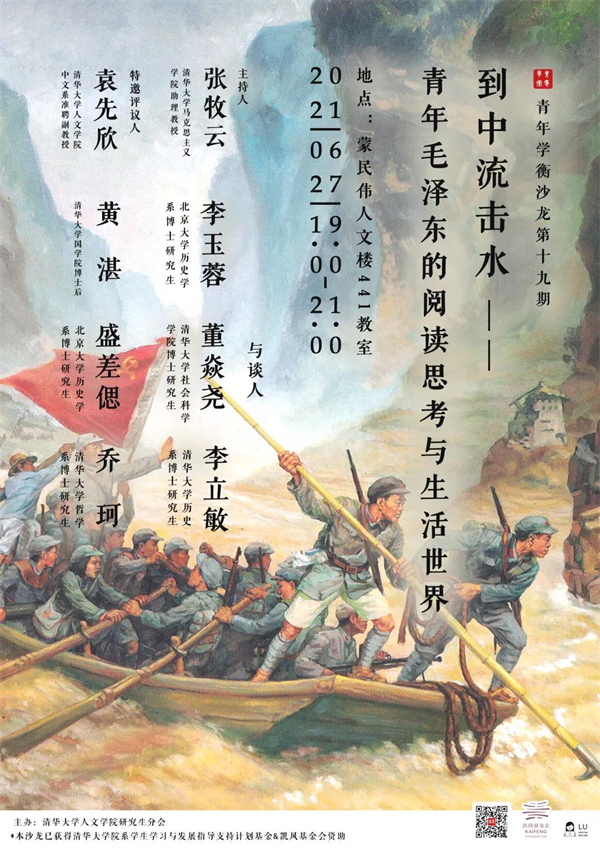
Beijing | hitting the water in the middle stream —— Young Mao Zedong’s reading thinking and life world
Time:June 27th (Sunday) 19:00-21:00.
Location:Room 441, Mengminwei Humanities Building, Tsinghua University, No.30 Shuangqing Road, Haidian District
Guest:Yuan Xianxin (Associate Professor of Chinese Department of Tsinghua University College of Humanities), Li Yurong (Ph.D. student of Peking University Department of History), Dong Yanyan (Ph.D. student of political science of Tsinghua University College of Social Sciences), etc.
In the early 20th century, China forged its youth era in the drastic social transformation. As a cultural symbol, "youth" not only symbolizes the most dynamic ideological form in the new world, but also reflects the national mentality of seeking change and striving for survival; At the same time, it is a thorough revaluation of all cultural values. The discussion in this salon focuses on the graduate students who are both in their youth. In the resonance of historical feelings, we will try to understand and think about the ideological change and revolutionary motivation of young Mao Zedong in combination with specific regional culture and characteristics of the times, so as to add a vivid and profound thinking material for us to understand the internal logic of modern history of China.
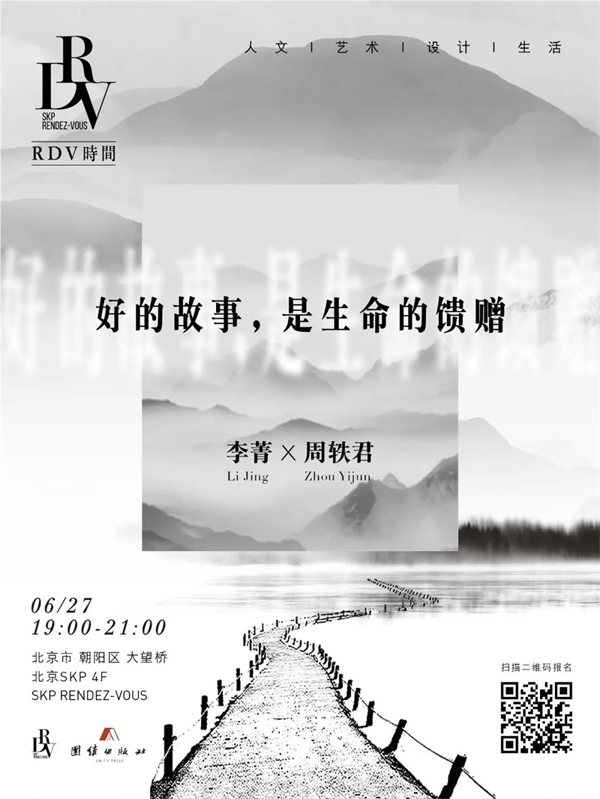
Beijing | A good story is a gift of life.
Time:June 27th (Sunday) 19:00-21:00.
Location:SKP RENDEZ-VOUS, 4th floor, Beijing SKP Shopping Center, No.87 Jianguo Road, Chaoyang District
Guest:Jing Li (deputy editor-in-chief of Sanlian Life Weekly) and Zhou Yijun (reporter and director)
On June 27th, Li Jing, deputy editor-in-chief of Sanlian Life Weekly, with a good story, and Zhou Yijun, a famous journalist and director, were in SKP, Beijing, to talk with you about books and hearts. Of course, in addition to the stories in the book, you also have the opportunity to hear the stories of the two guests themselves-about career, about family, about walking and about life. What is an excellent modern independent female benchmark? Maybe they are the answer.
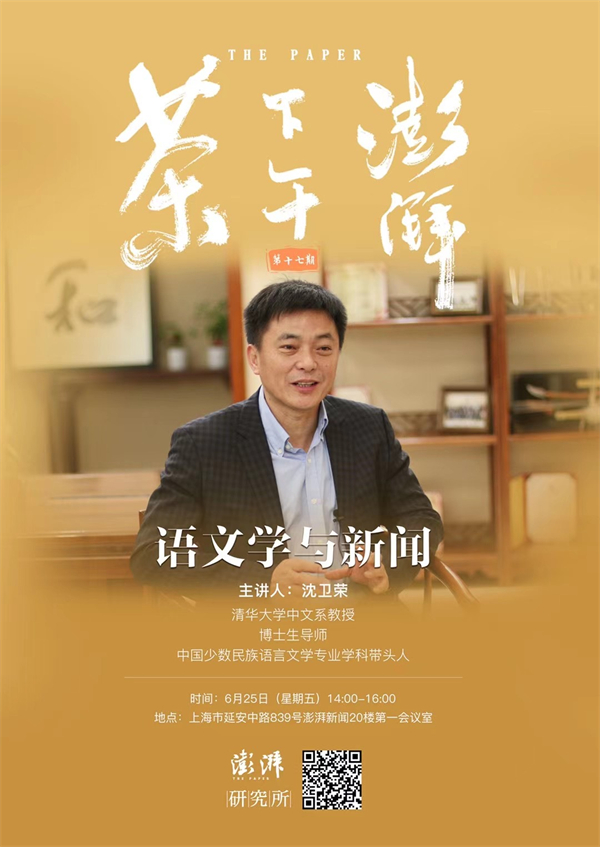
Shanghai | Literature and News
Time:June 25th (Friday) from 14: 00 to 16: 00.
Location:The first meeting room on the 20th floor of The Paper, No.839 Yan ‘an Middle Road, Jing ‘an District.
Speaker:Shen Weirong (Professor and Doctoral Supervisor, Chinese Department, Tsinghua University)
In the afternoon tea, Professor Shen Weirong from Tsinghua University was invited to give a lecture on Chinese literature and news.
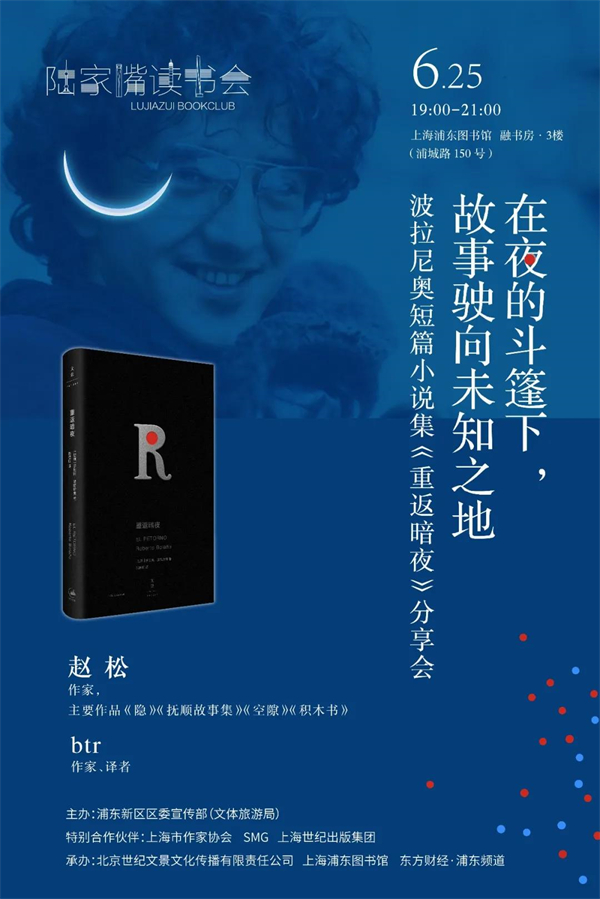
Shanghai | Under the cloak of night, the story sails to an unknown place —— Sharing meeting of Bola? o’s collection of short stories "Return to the Night"
Time:June 25th (Friday) 19:00-21:00.
Location:3/F, No.150 Pucheng Road, Pudong New Area, Shanghai Pudong Library Rong Study Room
Guest:Zhao Song (writer), btr (writer, translator, cultural critic)
In the collection of short stories "Back to the Dark Night", the characters in Bola? o’s novels still retain the background color of wanderers, but their identities and appearances have become more diverse. On Friday night, writer Zhao Song and writer and translator btr will visit Lujiazui Reading Club, starting from Return to Night, and take everyone to explore Bola? o’s literary universe.

Shanghai | If you don’t come, it’s going to snow —— Sharing Meeting of Mr. Mu Xin’s Chronicles
Time:June 25th (Friday) 19:00-21:00.
Location:Sinan Bookstore, No.517 Fuxing Middle Road, Huangpu District
Speaker:Xia Chunjin (scholar, reading promoter)
On the evening of June 25th, Xia Chunjin, the author of Mr. Mu Xin’s Chronicles, will be a guest at Sinan Bookstore, taking you to read this masterpiece of Mu Xin’s research, which has accumulated for eight years, and taking readers back to Mu Xin’s life.

Shanghai | The Blooming Moment of Daily Life —— A New Book Sharing Meeting of Little Sisters by Huang Yongmei
Time:June 26th (Saturday) 14:00-16:00.
Location:Sinan Literature House, No.505 Fuxing Middle Road, Huangpu District
Guest:Huang Yongmei (novelist), Guo Shuang (writer), Huang Dehai (deputy editor-in-chief of Sinan Literature) and Fang Yan (deputy editor-in-chief of Sinan Literature)
Daily hardships and difficulties, inner distance and longing often constitute a double-line narrative in Huang Yongmei’s novels, which makes her daily life look vast and Shu Lang, like a fierce and enthusiastic aunt, a persistent and sensitive female writer, a wandering and tenacious father … It is difficult for us to fix a face for Huang Yongmei’s stories. We can only say that this is life itself. In the 21st-century literary novels, in which gender is gradually abandoned, and under the tide of Internet culture, mature female writers represented by Huang Yongmei are trying to go deep into the vast spiritual world in the new century and hold up a changeable and determined world. On the afternoon of June 26th, Huang Yongmei will take her latest anthology of novels, Little Sisters, and discuss those blooming moments of daily life with writer Guo Shuang, critics Huang Dehai and Fang Yan.
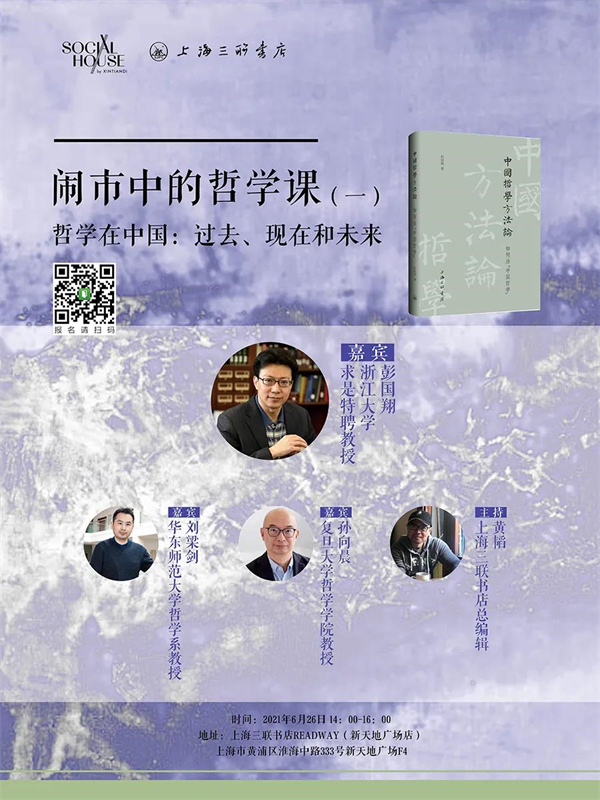
Philosophy Course in Shanghai | Downtown (I) —— Philosophy in China: Past, Present and Future
Time:June 26th (Saturday) 14:00-16:00.
Location:No.333 Huaihai Road, Huangpu District Xintiandi F4 Shanghai Sanlian Bookstore READWAY
Guest:Peng Guoxiang (seeking truth from distinguished professor, Zhejiang University), Sun Xiangchen (Dean and Professor, School of Philosophy, Fudan University) and Liu Liangjian (Dean and Professor, Department of Philosophy, East China Normal University).
Philosophy begins with curiosity, and everyone is a philosopher when looking up at the stars; Philosophy grew up in the city, and Socrates laid the foundation of philosophy in the noisy market of Athens. Philosophy is around us, and everyone has their own understanding of the world more or less. Even in this bustling downtown, we know that you care about more than the immediate prosperity. On the afternoon of June 26th, the first lecture of a series of lectures on "Philosophy in the Downtown" was given by Peng Guoxiang, a teacher from Qiushi distinguished professor, Zhejiang University. Not long ago, he just published a masterpiece "Methodology of China Philosophy: How to Treat" China Philosophy "; The two guests were Professor Sun Xiangchen, Dean of the School of Philosophy of Fudan University, and Professor Liu Liangjian from the Department of Philosophy of East China Normal University. The theme will revolve around the proposition "China’s Philosophy".
Shanghai | The Integration of Shanghai Culture and Jiangnan Culture
Time:14:00 on June 26th (Saturday)
Location:Academic lecture hall on the third floor of Putuo District Library, No.1800 Daduhe Road, Putuo District
Speaker:Cherish Jane (writer)
Cities have temperatures, blocks are suitable for walking, and buildings can be read. When we walk around the block and read the buildings, we can feel the foreign-style Shanghai in people’s eyes everywhere. In fact, it is also full of strong Jiangnan customs, which are covered by the buildings themselves and endowed by people living in them. This is unique to Shanghai, which is full of rivers and rivers, and is also created by Shanghai’s urban spirit. In this lecture, Shanghai writer Xi Zhen talks with you about the integration of Shanghai culture and Jiangnan culture.

Shanghai | Left-handed Finance, Right-handed Love —— The Press Conference of the New Book Between Rise and Fall
Time:June 26th (Saturday) 14:00-15:30.
Location:No.1834 Huaihai Middle Road, Xuhui District -1 Dayin Bookstore
Guest:Bei Bei (college teacher), Mu Ye (literary critic and poet), Wu Mei (editor-in-chief of Shanghai Education Press) and Ge Shuyi (novelist)
From the perspective of Shanghai World Financial Center, Beibei’s Between Ups and Downs depicts the bitter ups and downs in the financial market. On June 26th, we will hold "Left-handed Finance, Right-handed Love —— Between the Ups and Downs" in Wu Kang Road Store of Da Yin Bookstore to discuss the new form of social life under the financial wave.
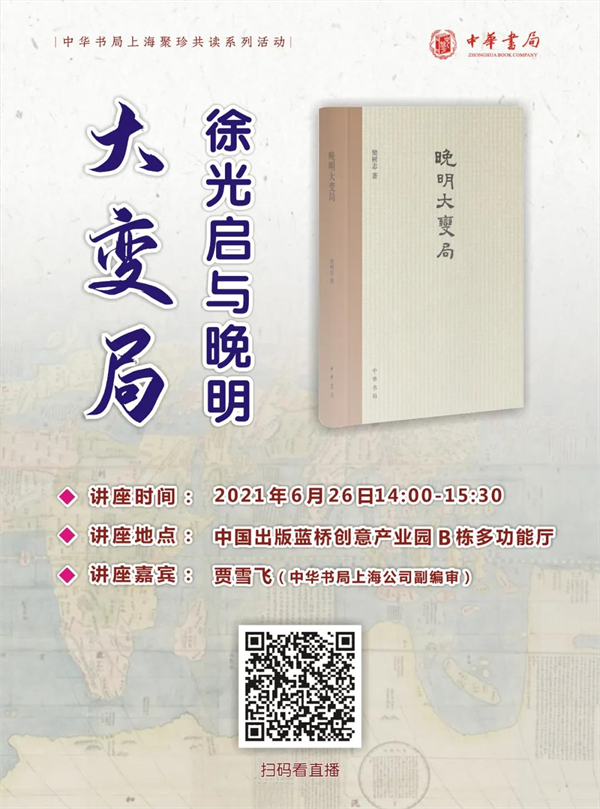
Shanghai | Xu Guangqi and the Great Changes in the Late Ming Dynasty
Time:June 26th (Saturday) 14:00-15:30.
Location:Multi-function Hall, Building B, China Publishing Lanqiao Creative Industrial Park, No.838 Guangji Road, Hongkou District
Speaker:Jia Xuefei (Deputy General Manager, Shanghai Juzhen Company, Zhonghua Book Company)
As a scholar who grew up in the traditional society of China, Xu Guangqi paid attention to the practice of solving people’s livelihood problems in the process of taking the imperial examination, treated the emerging western science and technology with an open mind and a pragmatic attitude, and tried to integrate it into Chinese culture for our use. The late Ming Dynasty experienced the first step of China’s integration into the world, which prompted a great change in the late Ming Dynasty, and Xu Guangqi was one of the representatives who promoted this change.

The Pure Confucian Style in Shanghai | Tang Poetry
Time:14:30 on June 26th (Saturday)
Location:China Space, 18th Floor, Xinhua Center, No.331 Caoxi North Road, Xuhui District
Speaker:Chen Shangjun (Professor, Chinese Department, Fudan University)
Professor Chen Shangjun specializes in literature and classical philology of Tang and Song Dynasties. He has devoted much effort to the collection and textual research of literature in Tang Dynasty and the study of writers’ lives and works in Tang and Song Dynasties. He is also engaged in the study of historical philology and stone carving philology. This Xinhua Zhiben Reading Club invited Mr. Chen Shangjun to give a lecture on the mellow Confucian style in Tang poetry.
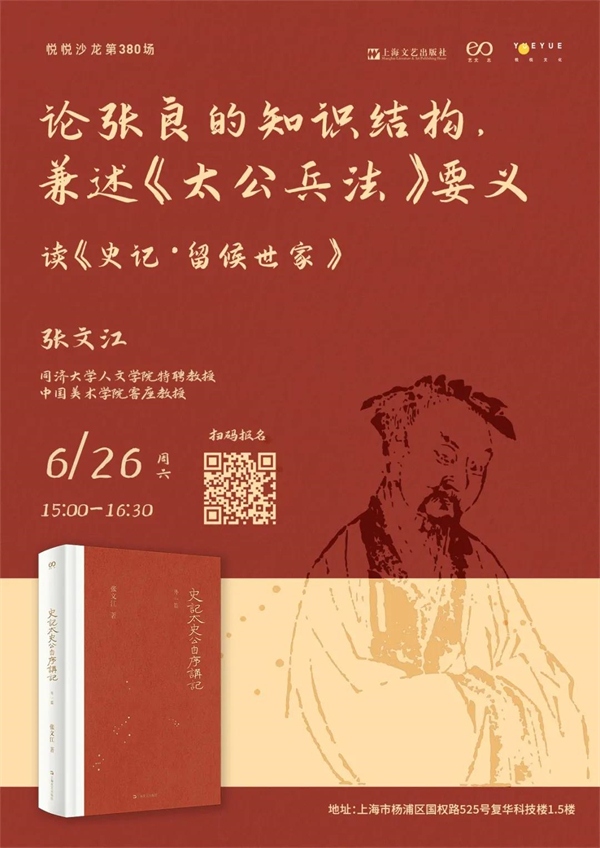
Shanghai | On Zhang Liang’s Knowledge Structure and the Essentials of Taigong’s Art of War —— Reading Historical Records: A Family Leaving Hou’s Family
Time:June 26th (Saturday) 15:00-16:30.
Location:Zhida Bookstore, Floor 1.5, Fuhua Science and Technology Building, No.525 Guoquan Road, Yangpu District, Activity Space
Speaker:Zhang Wenjiang (School of Humanities, Tongji University, distinguished professor)
In this lecture, Professor Zhang Wenjiang, a guest, will discuss the knowledge structure of Zhang Liang, the first hero of the Western Han Dynasty, and discuss the spread and essence of The Art of War, so as to understand what my father taught me.
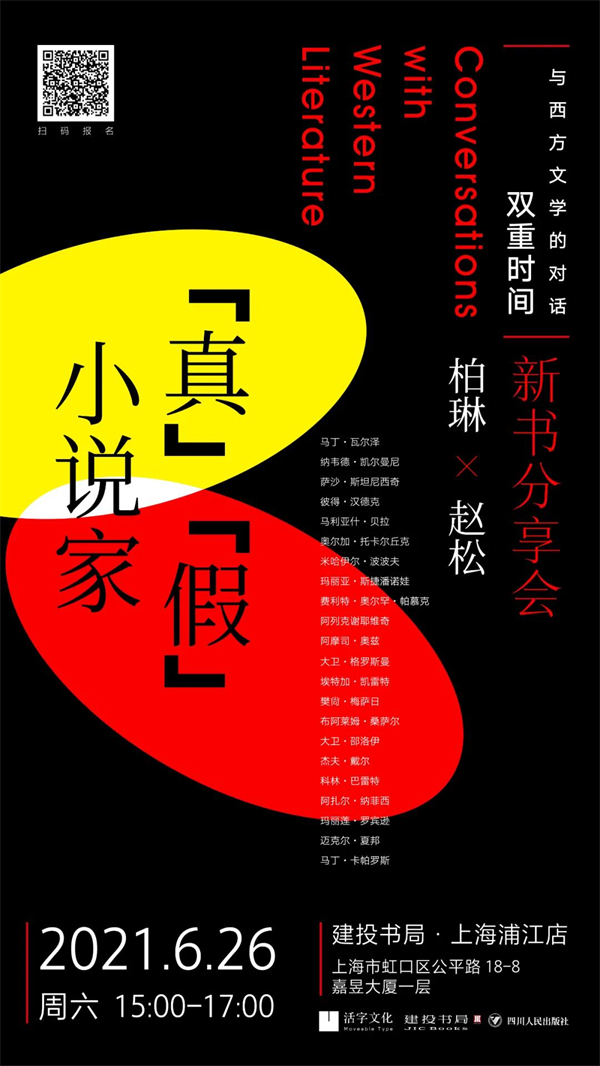
Shanghai | "True" and "False" Novelists —— Sharing Meeting of Double Time: Dialogue with Western Literature
Time:June 26th (Saturday) 15:00-17:00.
Location:4F Biography Library of Investment Press was built on the first floor of Jiayu Building, Building 8, No.18 Gongping Road, Hongkou District.
Guest:Bai Lin (cultural journalist and writer) and Zhao Song (writer)
In "Double Time", Berlin asks questions to dozens of writers who are well-known in the contemporary literary world, but not only talks about literature with them, but also often "wanders into social issues and moral issues". She not only pays attention to the writers’ status as "writers", but also presents readers with their diverse faces as humanists, investigative journalists, critics and even political participants, and their views on the world through these faces. For Zhao Song, the novel itself contains infinite possibilities. In this world, he is an "architect", constantly trying to build a new reality with words; He is also a "chemist", observing the chemical reactions brought about by fresh word combinations. On the afternoon of June 26th, Jiantou Bookstore, in conjunction with movable type culture, invited Bai Lin, who had interviewed many novelists, and Zhao Song, a novelist, to visit Jiantou Bookstore and Shanghai Pujiang Store to have a talk on the topic of "True and False Novelists". The so-called "truth" and "falsehood" are not meant to define "writer", and it is even possible that this dialogue will make this identity more chaotic.
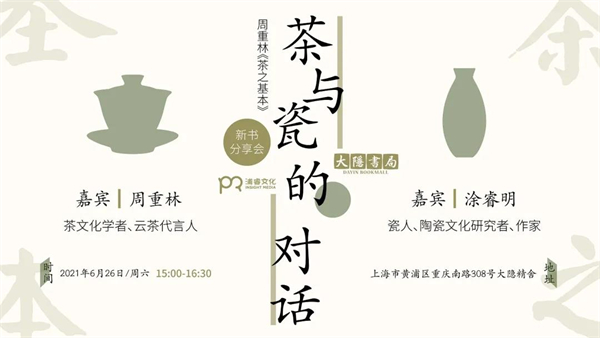
Shanghai | Dialogue between Tea and Porcelain —— Sharing Meeting of the New Book "Fundamentals of Tea"
Time:June 26th (Saturday) 15:00-16:30.
Location:Da Yin Jing She, No.308 Chongqing South Road, Huangpu District
Guest:Zhou Zhonglin (tea culture scholar) and Tu Ruiming (ceramic culture researcher and writer)
As we all know, tea begins with Lu Yu’s Tea Classic. The Book of Tea is the earliest, most complete and comprehensive monograph on tea in the world, and is known as the "encyclopedia of tea". The production of tea utensils is inseparable from ceramics. Tea and porcelain are both the essence of Chinese civilization and China’s great contribution to world material civilization, and they are closely related. On June 26th, Mr. Zhou Zhonglin, a well-known tea culture scholar and spokesperson of Yuncha, and Mr. Tu Ruiming, a well-known porcelain person and ceramic culture researcher, will visit Da Yin Bookstore and bring us their in-depth interpretation of the topic of tea and porcelain.
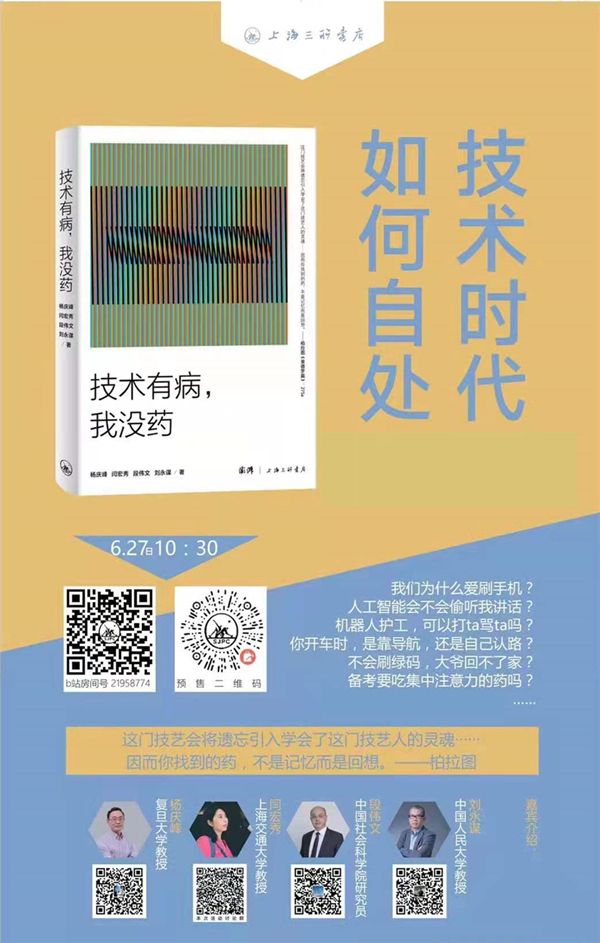
Shanghai | How to deal with yourself in the technological age
Time:10:30 on Sunday, June 27th.
Location:The bookstore 2F at the foot of the mountain, No.58 Foshan Road, Songjiang District.
Guest:Yang Qingfeng (Professor, Research Center for Biomedical Ethics, Fudan University), Yan Hongxiu (Professor, Institute of Science History and Science Culture, Shanghai Jiaotong University), Duan Weiwen (Researcher, Institute of Philosophy, China Academy of Social Sciences) and Liu Yongmou (Professor, School of Philosophy, China Renmin University).
Enjoy the consequences of technology, or give up the convenience of technology, everyone living in modern society, I’m afraid there is no choice-technology, agent of a variety of lifestyles. Yang Qingfeng, Yan Hongxiu, Duan Weiwen and Liu Yongmou, the professionals of philosophy of technology, are willing to talk about people in the future of technology in a semi-serious and semi-ridiculous way. They thought about 8 topics and wrote 32 semi-propositional compositions, expressing their similar or opposite views and wrestling with each other. This group of articles, some of which have been published in "澎湃 Ideological Market", has a click-through rate of 1 million+under the internet technology. Now several authors have compiled these articles into a small book. On the morning of June 27th, at the bookstore at the foot of the mountain (Foshan Road Store), please listen to their topic: the technological age and human enhancement.
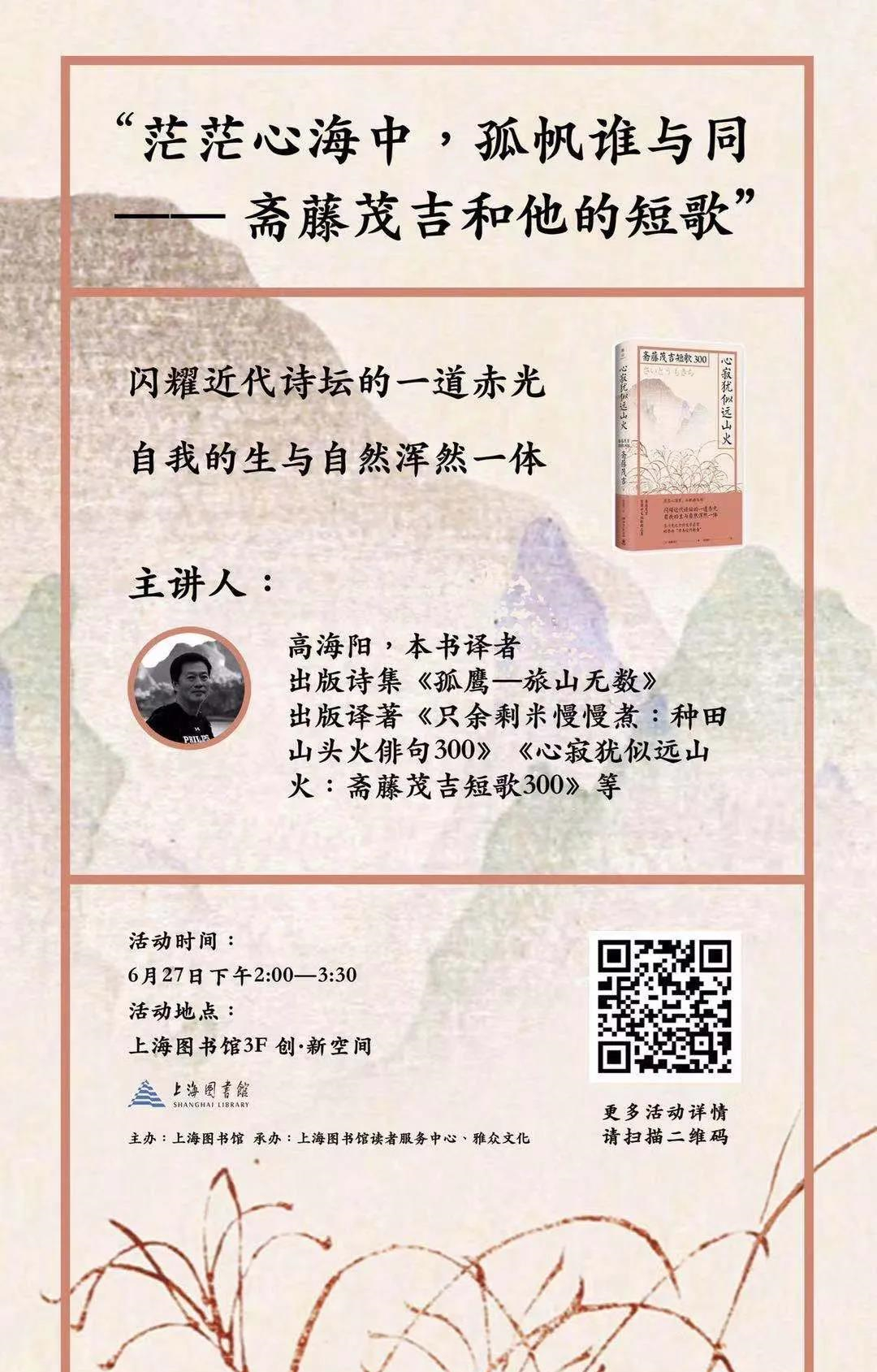
Shanghai | The vast sea in the heart, who is alone with the sail-Saito Maoji and his short songs
Time:June 27th (Sunday) 14:00-15:30
Location:Shanghai Library, No.1555 Huaihai Middle Road, Xuhui District, 3F creates a new space.
Speaker:Gao Haiyang (poet and translator)
"Short Song" began in the 6th and 7th centuries, and it is one of the many poetic styles of Japanese Wakayama. In modern times, many singers tried to innovate the traditional harmony songs. Shigeyoshi Saito is one of the leading figures in the modernization of short songs, and later has the reputation of "the sage of modern songs". On the afternoon of June 27th, Mr. Gao Haiyang, the translator of the first Chinese version of Shigeyoshi Saito’s short song anthology "My heart is still like a distant mountain fire: Shigeyoshi Saito’s short song 300", will be a guest at the sharing meeting of the above picture, reading the short song and haiku, the life of Shigeyoshi Saito, and his short songs full of emotion and tension, so as to lead readers to appreciate the red light shining in modern Japanese poetry circles.
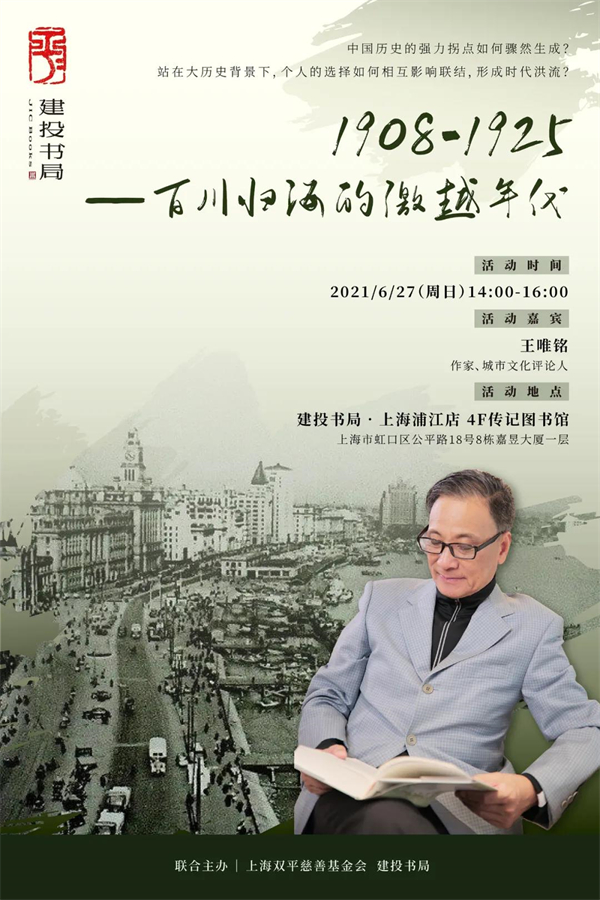
Shanghai | 1908-1925 —— The violent age when hundreds of rivers returned to the sea.
Time:June 27th (Sunday) 14:00-16:00
Location:4F Biography Library of Investment Press was built on the first floor of Jiayu Building, Building 8, No.18 Gongping Road, Hongkou District.
Speaker:Wang Weiming (writer, urban culture critic)
On the afternoon of June 27th, Jiantou Bookstore, together with Shanghai Shuangping Charity Foundation, invited Wang Weiming, a writer and critic of urban culture, to visit Jiantou Bookstore, Shanghai Pujiang Store, to unveil the historical features of the radical era from 1908 to 1925, to depict the figures in the background of the changing era, and to tell the evolution of ideological trend in the awakening era.
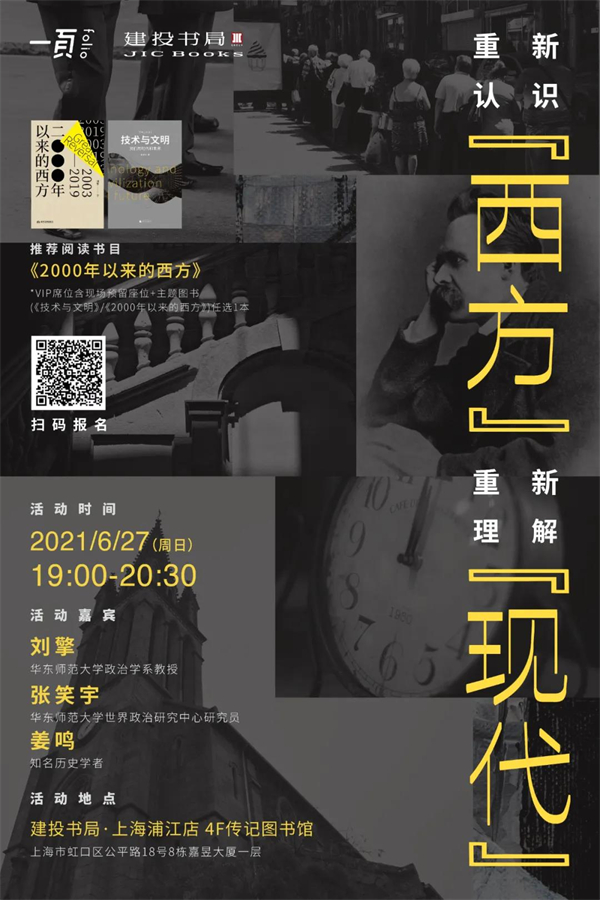
Shanghai | Re-understand "West" and "Modern"
Time:June 27th (Sunday) 19:00-20:30.
Location:4F Biography Library of Investment Press was built on the first floor of Jiayu Building, Building 8, No.18 Gongping Road, Hongkou District.
Guest:Liu Qing (Professor, Department of Political Science, East China Normal University), Zhang Xiaoyu (Researcher, Center for World Politics Studies, East China Normal University) and Ming Jiang (Historian).
How should we re-recognize and re-position the "West"? What happened in the west in the first 20 years of the 21st century, and what will happen in the future? This is discussed by Professor Liu Qing, a highly acclaimed tutor of Qipa Theory, in his new book "The West since 2000". Today in history, do we subconsciously think that the premise of "what is modern" is clear, the content already exists, and the benchmark has lived in reality? Zhang Xiaoyu, a young political scientist, put forward such a question in his new book Technology and Civilization: What exactly is a modern society? How did modern society come into being? Will different understandings of modern society tear the world apart? On June 27th, Jiantou Bookstore jointly invited Professor Liu Qing, the tutor of Qipa Shuo, Zhang Xiaoyu, a young political scientist, and Ming Jiang, a well-known historical scholar, to visit Jiantou Bookstore, Shanghai Pujiang Store, to share their observations on the West and their understanding of modern society over the years.
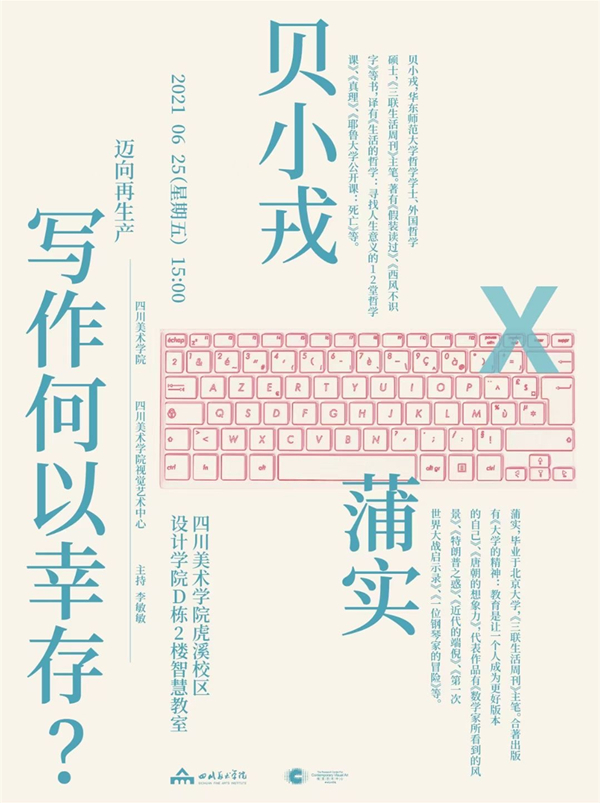
Chongqing | Towards Reproduction: Why Does Writing Survive?
Time:15:00 on Friday, June 25th.
Location:Wisdom Classroom, Floor 2, Building D, sichuan fine arts institute Design Institute, No.28 University Town South Road, Shapingba District
Guest:Bei Xiaorong (lead writer of Sanlian Life Weekly) and Pu Shi (lead writer of Sanlian Life Weekly)
Literature may belong to writers, but writing should belong to everyone. Today, new technology seems to bring diversified possibilities to writing. From blog to Weibo, online literature and artificial intelligence writing, writing has become more attractive. However, the technology and process of this production are still firmly controlled by the system, that is to say, under this more detailed control, writing (production) will inevitably lead to a boring. Why does writing survive? It seems to be urgent. Therefore, we look forward to becoming a real writer, to regain possession of these technologies and processes, and thus to reproduction.
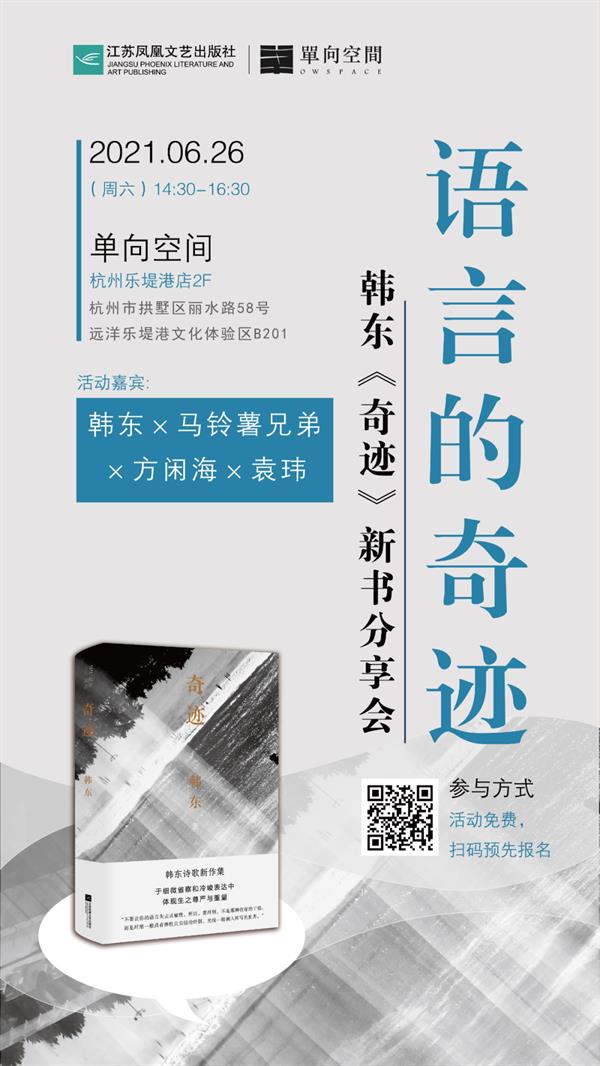
Hangzhou | The Miracle of Language —— A New Book Sharing Meeting of HanDong’s Miracle
Time:June 26th (Saturday) 14:30-16:30
Location:One-way space 2F, B201, Yuanyang Ledigang Cultural Experience Zone, No.58 Lishui Road, Gongshu District
Guest:HanDong (poet and novelist), Potato Brothers (poet), Fang Xianhai (poet and artist) and Yuan Wei (poet and artist).
What is the way of nature? What is the way of poetry? How to write "the artificial language of nature" On June 26th, HanDong will take the latest collection of poems "Miracle", which was launched after six years, and visit Hangzhou Ledigang Store with the poets Potato Brothers, Fang Xianhai and Yuan Wei to talk about the latest achievements of this poem creation and language exploration. Talk about the use of concrete, simple and clear words in poetry writing; Talk about the miracle of poetry created by language skills.
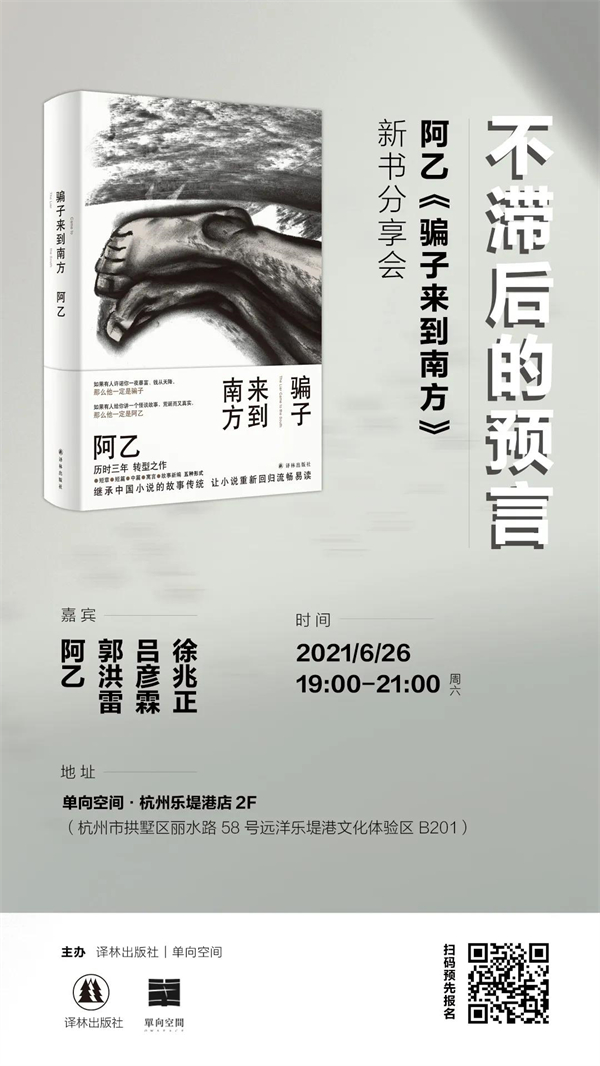
Hangzhou | Not Lagging Prophecy —— A B’s New Book Sharing Meeting of "The Liar Comes to the South"
Time:June 26th (Saturday) 19:00-21:00
Location:One-way space 2F, B201, Yuanyang Ledigang Cultural Experience Zone, No.58 Lishui Road, Gongshu District
Guest:A Yi (writer), Guo Honglei (professor and doctoral supervisor of School of Humanities, Hangzhou Normal University), Lv Yanlin (lecturer of School of Humanities, Hangzhou Normal University) and Xu Zhaozheng (doctor of Beijing Normal University).
In 2019, after writing the novella "The Liar Came to the South", A B defined it as: a lagging reflection of the social fact that the liar became a disaster. In 2021, A Yi found that fraud was still rampant, and the swindlers even had a great readiness to fight with us for a long time. This novel became a "not lagging prophecy". On the evening of June 26th, novelist A Yi took his new book "Liars Come to the South" as a guest in one-way space, and shared the contents of the new book and "not lagging behind" with scholars such as Guo Honglei, Lu Yanlin and Xu Zhaozheng.
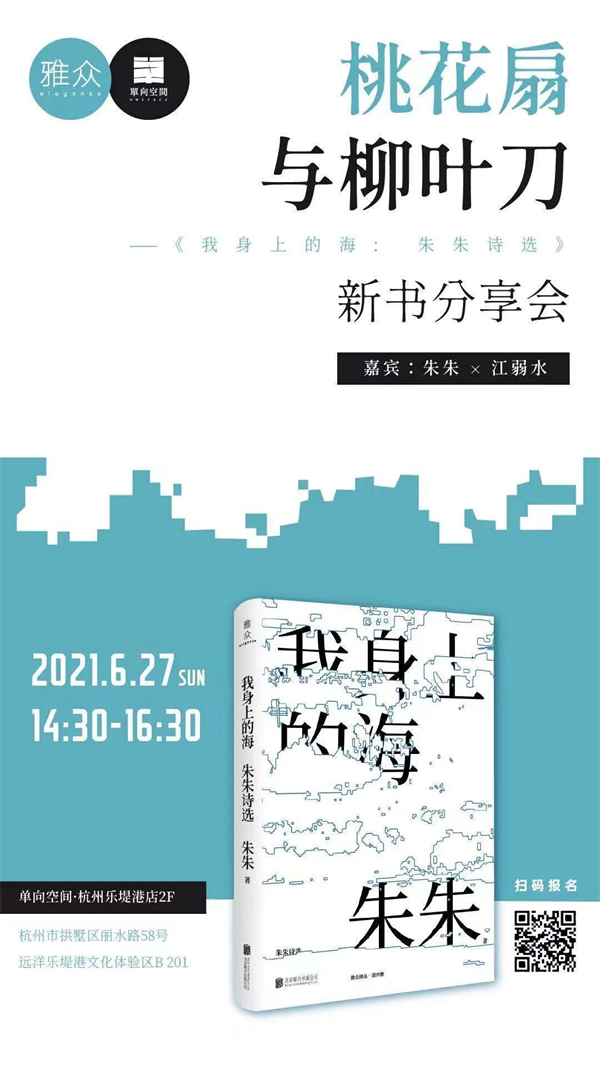
Hangzhou | Peach Blossom Fan and The Lancet —— A New Book Sharing Meeting of My Sea: Selected Poems of Zhu Zhu
Time:June 27th (Sunday) 14:30-16:30
Location:One-way Space B201, Yuanyang Ledigang Cultural Experience Zone, No.58 Lishui Road, Gongshu District
Guest:Zhu Zhu (poet) and Jiang Weak Water (poetry critic)
Zhu Zhu formed his elegant, subtle and restrained style in the 1990s. After entering the new century, his inner lyricism blended narrative, drama and other artistic elements. Through a series of more creative texts, he conveyed the depth of personal experience and the breadth of collective memory in the context of historical changes and contemporary life. In 2021, Yazhong Poetry Collection newly published the first anthology of Zhu Zhu’s 30-year writing-"My Sea: Selected Poems of Zhu Zhu". On the afternoon of June 27th, the poet Zhu Zhu and the poetry critic Jiang Ruanshui will visit the One-way Space Hangzhou Ledigang Store, and take this anthology of poems as the thread to lead everyone into Zhu Zhu’s poetry world.

Hangzhou | Restatement of the Basics of China Tea —— A New Book Sharing Meeting of the Basics of Tea in Zhou Zhonglin
Time:June 27th (Sunday) 19:00-21:00.
Location:One-way space 3F, B201, Yuanyang Ledigang Cultural Experience Zone, No.58 Lishui Road, Gongshu District, literary scene
Guest:Zhou Zhonglin (tea culture scholar) and Pan Cheng (scholar and writer)
Lu Yu wrote Tea Classic in order to liberate tea from the secular way of eating, while Zhou Zhonglin wrote The Basics of Tea in order to regain the elegant tradition of tea in China and spread the tea culture in China. On the evening of June 27th, Zhou Zhonglin, a scholar of tea culture, and Pan Cheng, a scholar and writer, visited Hangzhou Ledigang Store, a one-way space, to talk about the enlightenment of Lu Yu’s Tea Classic and trace back to the source of tea culture in China.

Nanjing | Happy birthday, little prince-Saint Exupery’s birthday commemoration
Time:19:00 on Friday, June 25th.
Location:Pioneer bookstore, No.173 Guangzhou Road, Gulou District
Guest:Huang Hong (Professor, Doctoral Supervisor, French Department, Nanjing University), Dan Hansong (Professor, English Department, Nanjing University), Qin Wen (Lecturer and Translator, School of Foreign Languages, Nanjing University)
June 29th is the birthday of Saint Exupé ry, a famous French writer. The Little Prince written by him has been translated into more than 300 languages and touched countless hearts. On the evening of June 25th, Huang Yong, a professor of French Department of Nanjing University, will visit pioneer bookstore with his translations The Little Prince and The Encyclopedia of the Little Prince, and The Stars and Roses of the Little Prince: A Biography of Saint Exupé ry by Schiff, a Pulitzer Prize winner, to review the romantic life of Saint Exupé ry and share the depth of his works.
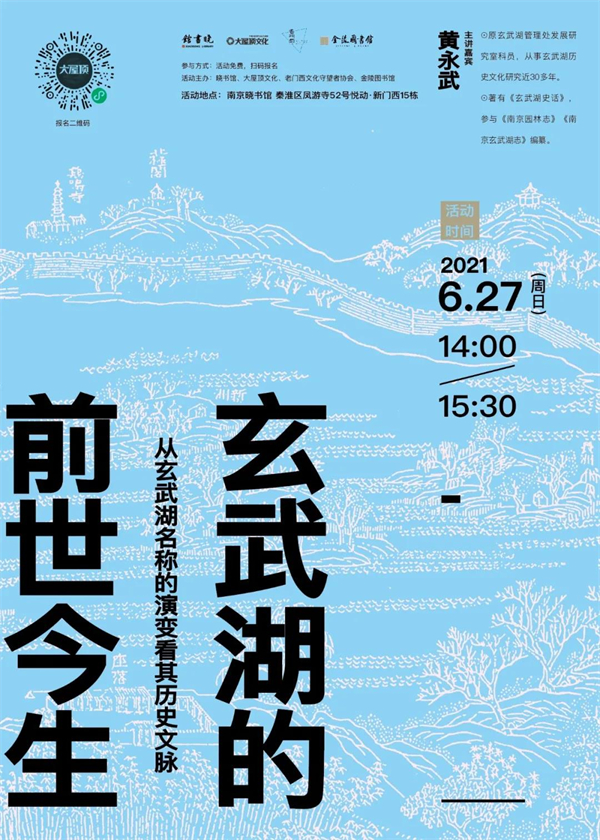
Nanjing | past lives of Xuanwu Lake —— Looking at the historical context of Xuanwu Lake from the evolution of its name
Time:June 27th (Sunday) 14:00-15:30
Location:Building 16, Yuedong Xinmenxi, No.52 Fengyou Temple, Qinhuai District, Xiaoshuguan
Speaker:Huang Yongwu (former member of the Development Research Office of Xuanwu Lake Management Office)
In the long history of nearly two thousand years, Xuanwu Lake has become a hotbed of culture and art, which has had a certain impact on the historical and cultural development of Nanjing. Many people of the hour have left immortal legends and poems for Xuanwu Lake. On June 27th, Big Roof Culture invited Huang Yongwu, a former member of the Development Research Office of Xuanwu Lake Management Office, to visit Nanjing Xiaoshu Library, and "look at the historical context of Xuanwu Lake from the evolution of its name" with readers on the theme of "past lives of Xuanwu Lake".
Nanjing | Meiyuan Classic Reading Group No.34: "Nine Kings Seize the Office"
Time:June 27th (Sunday) 15:00-17:30
Location:Wanxiang Bookstore, No.8 Jinyinjie, Gulou District
Speaker:Zheng Xiaoyou (Deputy Research Librarian of National Library), Li Xiaobo (Lecturer of History Department of Nanjing Normal University) and Xia Xia (History and Culture Lover).
"Nine Kings Seize the Office" is Dr. Zheng Xiaoyou’s third popular reading of political history in Qing Dynasty, which is a bridge between academic history research and public history reading. Behind it is the author’s desire to break the shackles of people’s procedural and facebook thinking when observing history, which is admirable. The thirty-fourth salon of Meiyuan Classic Reading Group will focus on this book by Zheng Xiaoyou.

Xi ‘an | Research on Ancient Stone Inscriptions and Medieval History of China in Japanese Collection.
Time:June 25th (Friday) 19:00-21:00.
Location:Meeting room (Room 1-11) on the first floor of History College, History Building, Chang ‘an Campus, Northwest University, No.1 Xuefu Avenue, Chang ‘an District
Speaker:Xia Yan (Professor and Doctoral Supervisor, School of History, Nankai University)
Professor Xia Yan’s main research directions are social history, environmental history and institutional history of Wei, Jin, Southern and Northern Dynasties, Sui and Tang Dynasties. In the fourth lecture of "Chen Zhi Memorial Lecture", we invited Professor Xia Yan to give a lecture on the ancient stone carving materials in China and the study of medieval history.

Xi ‘an | Awakens the warm memory of food and local conditions.
Time:June 26th (Saturday) 15:00-17:00.
Location:SKP RENDEZ-VOUS, activity area, 9th floor, Xi ‘an SKP Shopping Center, No.261 Chang ‘an North Road, beilin district.
Guest:Zhu Xuedong (freelance writer and columnist) and Duan Wanjin (lawyer)
The taste of Jiangnan drifting away, the simple love and affection for food and dishes, the respect and admiration for nature in seasonal solar terms, and the feedback from nature to people’s tenacious will to survive continue from life to this book "People’s Diet". What’s your favorite food after climbing mountains and crossing the sea? What are your childhood memories? In the land of Guanzhong, where the wine is warm and the ears are hot, which store do you often drink and chat with your friends? On June 26th, Zhu Xuedong will take his new book "People’s Diet" to visit SKP RENDEZ-VOUS in Xi ‘an, and show us his food map, hometown food notes and private food list.

Xi ‘an | Cross-cultural Dialogue: From Fudan to Oxford —— Sharing Meeting of Oxford Notes in Xi ‘an
Time:June 26th (Saturday) 19:00-20:30
Location:SKP RENDEZ-VOUS, activity area, 9th floor, Xi ‘an SKP Shopping Center, No.261 Chang ‘an North Road, beilin district.
Guest:Zhang Lifen (Professor and Doctoral Supervisor of School of Journalism, Fudan University), Xu Jiabiao (Vice President, Professor and Doctoral Supervisor of School of Journalism and Communication, Shaanxi Normal University), Liu Xiaorong (writer and media person).
Different from other notebook works, Zhang Lifen’s Oxford Notes has brought us a long-lost stranger experience. His language is like floating ice in the sea of Wang Yang, which is fragmented, warm and eloquent at the same time. By reading his words, we can feel his lovely soul and broad vision. On June 26th, Zhang Lifen, the author of the new book "Oxford Notes", talked with guests Xu Jiabiao and Liu Xiaorong about Britain and Oxford that you didn’t know, and shared the story behind the creation with readers.
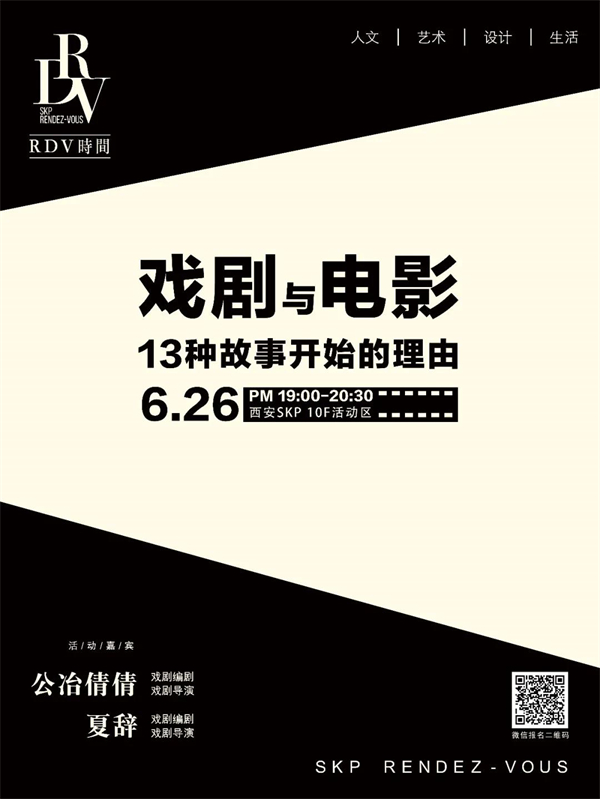
Xi ‘an | Drama and Movies —— Reasons for the Beginning of 13 Stories
Time:June 26th (Saturday) 19:00-20:30
Location:SKP RENDEZ-VOUS, activity area, 10th floor, Xi ‘an SKP Shopping Center, No.261 Chang ‘an North Road, beilin district.
Guest:Gong Yeqian (screenwriter and director) and Xia Ci (screenwriter and director)
On June 26th, we invited playwright and drama director Gong Yeqian and Xia Ci. They will compare and analyze the opening ways of quentin tarantino’s works and many other drama works, a legend in film history, so as to let everyone participate in it and feel the corresponding embodiment of the opening ways of the film in the drama on the basis of demonstrating examples.

Xi ‘an | Restoring the Gorgeous World of the Ancient People —— Sharing Meeting of New Books of Beauty Map and Interesting Archaeology
Time:June 27th (Sunday) 14:00-16:00
Location:Fang Fangli Laboratory, Floor 1, Laochenggen Gpark Shopping Center, No.22 Xinghuo Road, Lianhu District
Guest:Meng Hui (researcher and writer of China traditional material culture) and Xu Weihong (researcher and writer of Shaanxi Archaeological Research Institute).
This Sunday, Meng Hui, a researcher and writer of China’s traditional material culture, will come to Xi ‘an Fangfang Bookstore with her new work "The Picture of Beauty" to understand the ancients’ pursuit of beauty from the details of ancient daily life and arouse readers’ re-imagination of classical beauty.
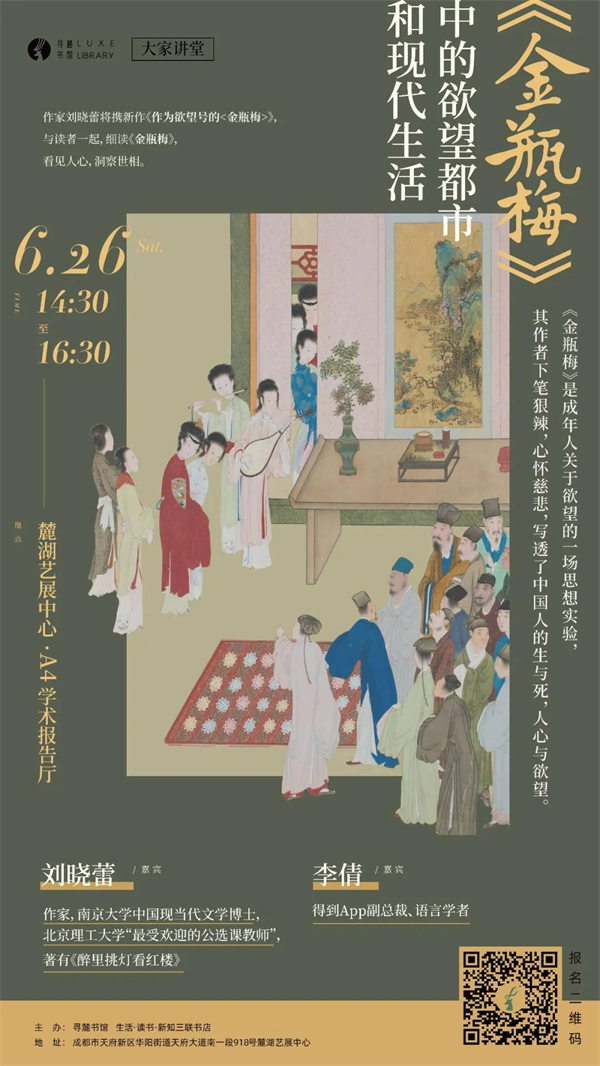
Chengdu | Sex and the City and Modern Life in Jin Ping Mei
Time:June 26th (Saturday) 14:30-16:30
Location:No.918, South Section 1 of Tianfu Avenue, Tianfu New District Luhu Art Exhibition Center A4 Academic Lecture Hall
Guest:Liu Xiaolei (writer) and Li Qian (vice president of App, linguist)
On June 26th, Liu Xiaolei, a writer, will take her new work "Jin Ping Mei as Desire" as a guest, and together with Li Qian, a vice president and linguist, will show you this great book of life and death of mortals. Welcome readers to read Jin Ping Mei carefully with Liu Xiaolei, see people’s hearts and gain insight into the world; Think about life and death, stay away from fear, let go of arrogance and prejudice, and gain the ability to love.
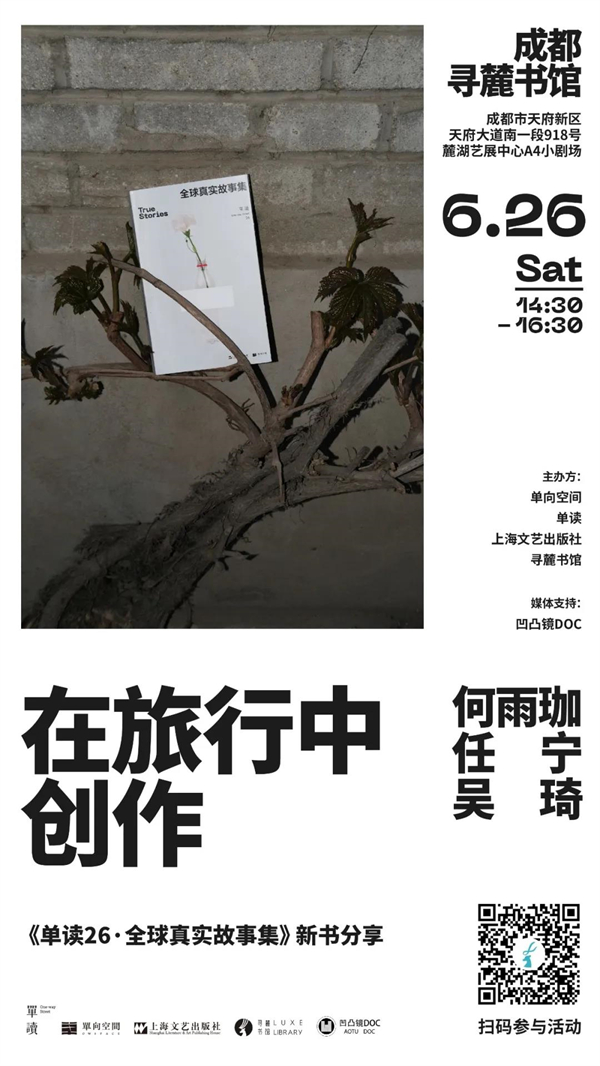
Chengdu | Creating in Travel —— Sharing the New Books of Single Reading 26 Global True Stories Collection
Time:June 26th (Saturday) 14:30-16:30
Location:No.918, South Section of Tianfu Avenue, Tianfu New District Luhu Art Exhibition Center A4 Small Theater
Guest:He Yujia (translator), Ren Ning (founder of venture capital fund) and Wu Qi (editor-in-chief of Single Reading)
Finding the topic during the trip is the favorite way of Single Reading. "Single Reading 26 Global True Stories Collection" can be said to be born by a trip. Today’s three guests are not only lovers of travel, but also beneficiaries of travel. So, is it possible to create while traveling? What kind of influence did travel bring to them? Under the epidemic, how did they change the direction of travel and what new discoveries did they make? On the afternoon of June 26th, let’s talk about travel and creation together.
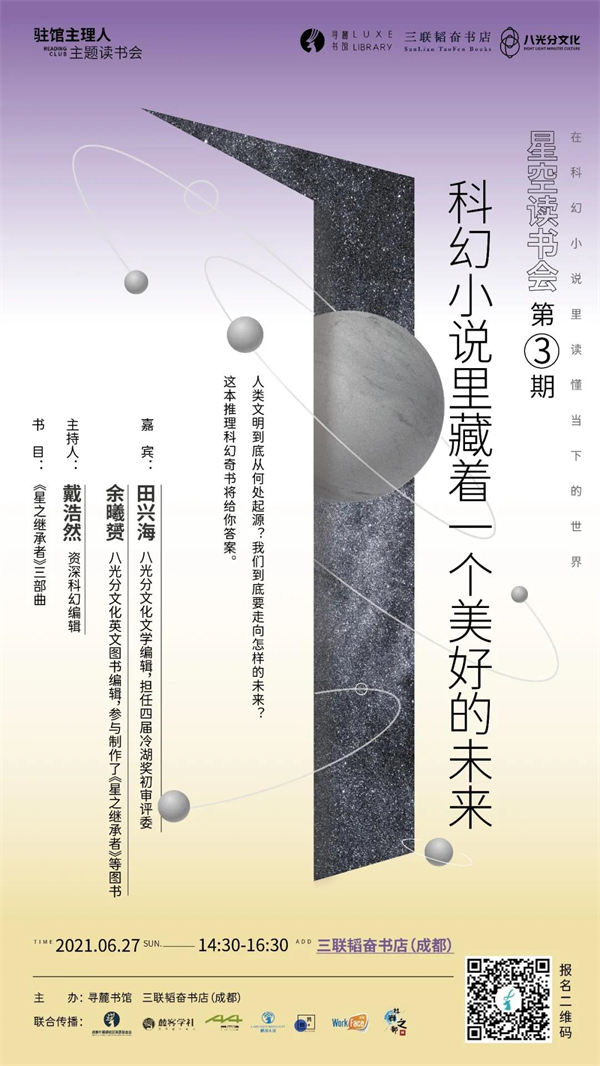
Chengdu | There is a bright future hidden in science fiction.
Time:June 27th (Sunday) 14:30-16:30
Location:Qingyang District Kuanzhai Lane No.30 Sanlian Taofen Bookstore
Guest:Yu Xiyun (editor of cultural English book in Baguangfen) and Tian Xinghai (editor of cultural literature in Baguangfen and author of science fiction)
On June 27th, Dai Haoran, a senior sci-fi editor, will invite Tian Xinghai and Yu Xiyun, editors of "The Inheritor of the Stars", to reveal the origin of human civilization for you. What kind of future are we going to? We are still willing to believe that life will always find a way out! The driving force that drove the fish to climb ashore hundreds of millions of years ago pushed us to struggle for a lifetime! No matter where humans come from, these billions of stars have been handed over to us to inherit!

Chengdu | "Casting Sword": A Visual Freshman of Literary Classics —— A Meeting of Picture Book Writers with Yesterday’s Wine
Time:14:30 on Sunday, June 27th.
Location:Step activity area on the first floor of Wenxuan BOOKS, Jiufang Shopping Center, No.88 Middle Section of Fucheng Avenue, High-tech Zone
Speaker:Xijiu (picture book writer)
On June 27th, the first meeting of Casting Sword was held. We invited the picture book writer-Xijiu, who took us back to Lu Xun’s classic stories with her colorful brushstrokes, to visit Wenxuan BOOKS Jiufang Store and share the mystery and novelty behind the image creation with us.

Zhengzhou | The Aesthetic World in the Shaking of Chai Skirt —— Sharing Meeting of the New Book of Beauty Map
Time:June 26th (Saturday) 15:00-17:00.
Location:Jinshui District Wenhua Road No.2 Songshe Bookstore
Guest:Meng Hui (researcher and writer of traditional material culture in China) and Li Hong (vice president of Chinese Han Painting Society)
Meng Hui’s latest work, Beauty Map, not only focuses on the clothes of ancient people, but also reveals how ancient women used aesthetic wisdom to all levels of food, clothing, housing and transportation. This Saturday afternoon, she will be a guest at Songshe Bookstore, and together with teacher Li Hong, she will explain "the aesthetic world of hairpin skirt swaying".
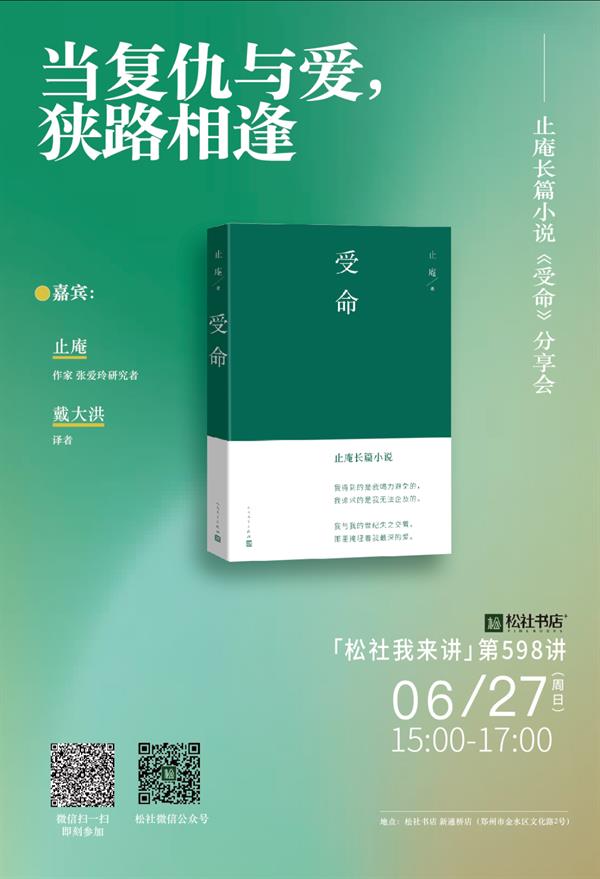
Zhengzhou | When Revenge and Love Meet in a Narrow Way —— Sharing Meeting of Zhi ‘an’s Novel "Being Ordered"
Time:June 27th (Sunday) 15:00-17:00
Location:Jinshui District Wenhua Road No.2 Songshe Bookstore
Guest:Zhi ‘an (writer and scholar) and Dai Dahong (translator)
Being ordered is the first novel of Zhian, which is about memory and love. Memory comes from the past and has not yet left. Love points to new life, but it cannot grow. On Sunday afternoon, writer, Zhang Ailing researcher Zhi ‘an and translator Dai Dahong will visit Songshe Bookstore to share the revenge and love in The Order with readers.
